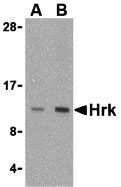Hrk Antibody
- SPECIFICATION
- CITATIONS
- PROTOCOLS
- BACKGROUND

Application
| WB, E |
|---|---|
| Primary Accession | O00198 |
| Other Accession | NP_003797, 4504493 |
| Reactivity | Human, Mouse |
| Host | Rabbit |
| Clonality | Polyclonal |
| Isotype | IgG |
| Calculated MW | Predicted: 10 kDa Observed: 12 kDa |
| Application Notes | Hrk antibody can be used for the detection of Hrk by Western blot at 2.5 - 5 µg/mL. |
| Gene ID | 8739 |
|---|---|
| Other Names | Hrk Antibody: DP5, HARAKIRI, BID3, Activator of apoptosis harakiri, BH3-interacting domain-containing protein 3, harakiri, BCL2 interacting protein (contains only BH3 domain) |
| Target/Specificity | HRK; |
| Reconstitution & Storage | Hrk antibody can be stored at 4℃ for three months and -20℃, stable for up to one year. As with all antibodies care should be taken to avoid repeated freeze thaw cycles. Antibodies should not be exposed to prolonged high temperatures. |
| Precautions | Hrk Antibody is for research use only and not for use in diagnostic or therapeutic procedures. |
| Name | HRK |
|---|---|
| Synonyms | BID3 |
| Function | Promotes apoptosis. |
| Cellular Location | Membrane; Single-pass membrane protein. Mitochondrion |

Thousands of laboratories across the world have published research that depended on the performance of antibodies from Abcepta to advance their research. Check out links to articles that cite our products in major peer-reviewed journals, organized by research category.
info@abcepta.com, and receive a free "I Love Antibodies" mug.
Provided below are standard protocols that you may find useful for product applications.
Background
Hrk Antibody: Apoptosis plays a major role in normal organism development, tissue homeostasis, and removal of damaged cells. Hrk, a pro-apoptotic member of the Bcl-2 homology domain-3 (BH3)-only group of the Bcl-2 family of proteins, was also identified as novel protein induced during programmed neuronal death. It lacks significant homology to other Bcl-2 family members except for an 8-amino acid region that is similar to the BH3 motif of Bik. Hrk regulates apoptosis through interaction with the anti-apoptotic proteins Bcl-2 and Bcl-XL via this domain. It does not interact with the pro-apoptotic proteins Bax, Bak, or Bcl-XS. Hrk localizes to mitochondrial membranes in a pattern similar to that previously reported for Bcl-2 and Bcl-XL.
References
Lockshin RA, Osborne B, and Zakeri Z. Cell death in the third millennium. Cell Death Differ. 2000; 7:2-7.
Imaizumi K, Tsuda M, Imai Y, et al. Molecular cloning of a novel polypeptide, DP5, induced during programmed neuronal death. J. Biol. Chem. 1997; 272:18842-8.
Inohara N, Ding L, Chen S, et al. harakiri, a novel regulator of cell death, encodes a protein that activates apoptosis and interacts selectively with survival-promoting proteins Bcl-2 and Bcl-XL. EMBO J. 1997; 16:1686-94.
If you have used an Abcepta product and would like to share how it has performed, please click on the "Submit Review" button and provide the requested information. Our staff will examine and post your review and contact you if needed.
If you have any additional inquiries please email technical services at tech@abcepta.com.













 Foundational characteristics of cancer include proliferation, angiogenesis, migration, evasion of apoptosis, and cellular immortality. Find key markers for these cellular processes and antibodies to detect them.
Foundational characteristics of cancer include proliferation, angiogenesis, migration, evasion of apoptosis, and cellular immortality. Find key markers for these cellular processes and antibodies to detect them. The SUMOplot™ Analysis Program predicts and scores sumoylation sites in your protein. SUMOylation is a post-translational modification involved in various cellular processes, such as nuclear-cytosolic transport, transcriptional regulation, apoptosis, protein stability, response to stress, and progression through the cell cycle.
The SUMOplot™ Analysis Program predicts and scores sumoylation sites in your protein. SUMOylation is a post-translational modification involved in various cellular processes, such as nuclear-cytosolic transport, transcriptional regulation, apoptosis, protein stability, response to stress, and progression through the cell cycle. The Autophagy Receptor Motif Plotter predicts and scores autophagy receptor binding sites in your protein. Identifying proteins connected to this pathway is critical to understanding the role of autophagy in physiological as well as pathological processes such as development, differentiation, neurodegenerative diseases, stress, infection, and cancer.
The Autophagy Receptor Motif Plotter predicts and scores autophagy receptor binding sites in your protein. Identifying proteins connected to this pathway is critical to understanding the role of autophagy in physiological as well as pathological processes such as development, differentiation, neurodegenerative diseases, stress, infection, and cancer.


